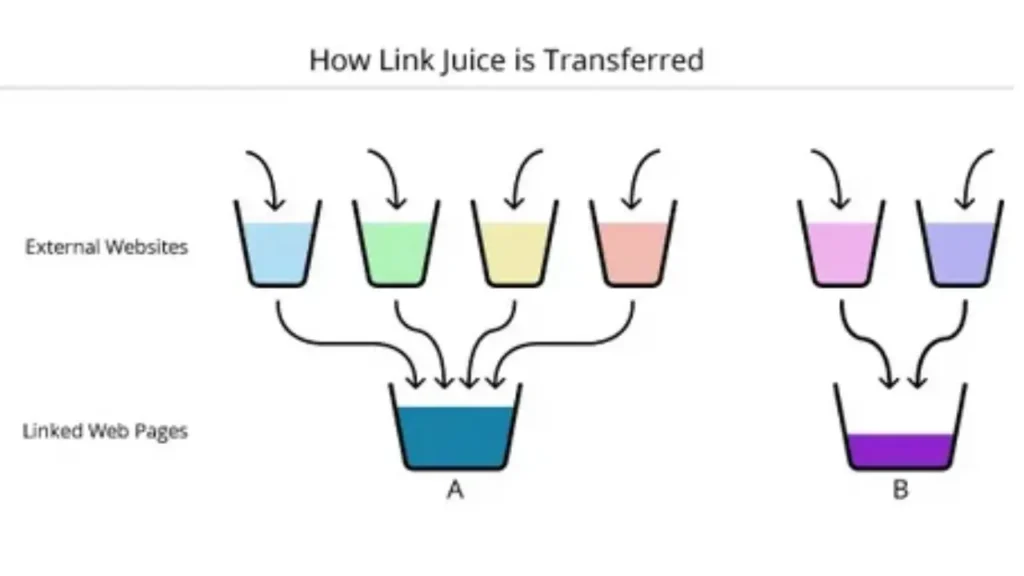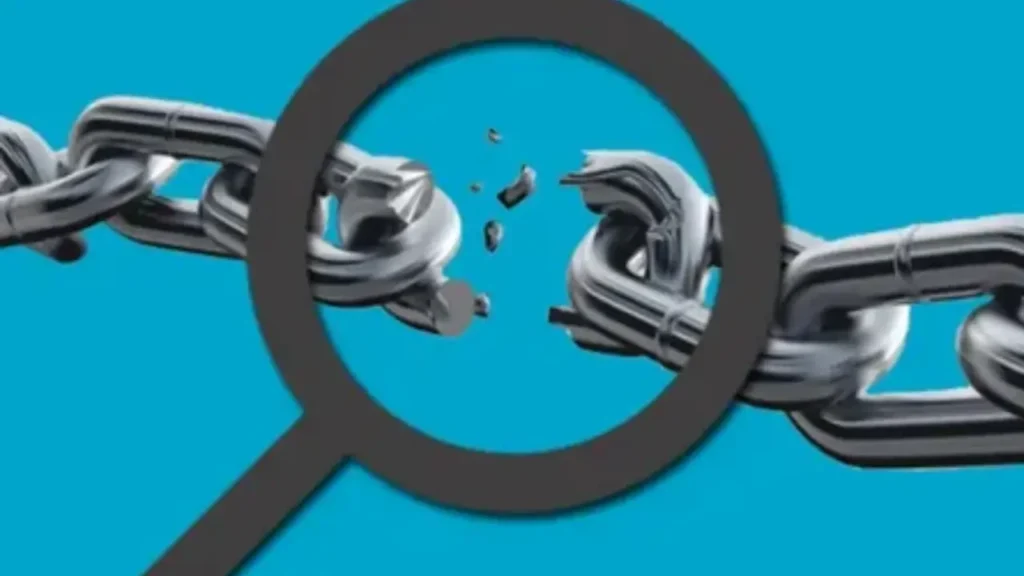What Are Backlinks?
A backlink is a link from one website to another. Think of it as a recommendation—when a website links to your site, it’s like giving your content a vote of confidence.
Search engines like Google see backlinks as a sign that your website is valuable and trustworthy, which can help improve your ranking in search results. The more strong and authentic backlinks you get, the better your website’s chances of ranking higher in search results and visibility online.
Why Are Backlinks Important for SEO?
Backlinks play a major role in search engine optimization (SEO). Search engines like Google see backlinks as a sign of trust and authority. The more quality backlinks your website has, the more likely it is to rank higher in search results. Backlinks help:
- Drive traffic to your website.
- Build credibility and trust.
- Improve your search engine rankings.
1. Types of Backlinks
Not all backlinks are the same. Here are the main types:
- Do follow Backlinks: These pass SEO value to your website, helping improve rankings.
- No follow Backlinks: These don’t pass SEO value but can still bring traffic.
- Natural Backlinks: Earned organically when someone links to your content without being asked.
- Artificial Backlinks: Created intentionally, like through guest blogging or link exchanges.
Common Myths About Backlinks
There are many misconceptions about backlinks. Let’s clear up a few:
- Myth 1: “More backlinks are always better.” Quality matters more than quantity.
- Myth 2: “All backlinks are good for SEO.” Toxic backlinks can harm your rankings.
- Myth 3: “Buying backlinks guarantees success.” Paid links often violate Google’s guidelines and can result in penalties.
2. How Backlinks Impact Your Website’s SEO
Backlinks as a Ranking Factor
Google’s algorithm considers backlinks as one of its top ranking factors. If many trusted websites link to your website, Google accepts that your website is authentic and valuable.
Link Juice: What It Is and How does It Works?

“Link juice” is a term used to describe the value or authority that one website passes to another through a backlink. For example, if a high-authority website links to your site, it shares some of its authority with you, boosting your SEO.
How Backlinks Improve Domain Authority (DA) and Page Authority (PA)
Domain Authority (DA) and Page Authority (PA) are scores that measure the power of a website and its individual pages. High-quality backlinks help increase these scores, making your website more competitive in search results.
The Role of Backlinks in User Engagement
Backlinks do more than improve SEO. They can also drive engaged users to your site. For example:
- Visitors who come from backlinks are often interested in your content.
- High-quality traffic from backlinks can lead to better on-site engagement metrics, like time on page and lower bounce rates.
3. Different Types of Backlink Strategies
Backlinks are external links from other websites that direct users to your site. They serve as a vote of confidence, signaling to search engines that your content is valuable and real. A well-structured backlink profile builds up your website’s authority, improves search rankings, and drives targeted traffic. Below are some of the most effective backlink strategies explained in a clear and direct manners which provide do follow and no follow backlinks:
1. Guest Posting
Guest posting is one of the most powerful ways to get high-quality do-follow backlinks. It involves writing and publishing articles on other websites within your niche. In return, you get a backlink to your website, often within the content or author bio. To make the most out of this strategy:
- Avoid spammy guest posting on low-quality sites, as this can harm your SEO.
- Target reputable websites with high domain authority.
- Write high-quality, original content that provides value.
2. Broken Link Building

Broken links are hyperlinks that are not working due to reasons such as deleted pages, changed URLs, or websites not working. These links lead users to not working pages, negatively impacting user experience and website credibility. Broken link building is a strategy where you find these non-functional links on other websites and offer your content as a replacement. Since website owners want to maintain a good user experience, they are often open to swapping broken links for active, relevant ones. To succeed with this strategy:
- Use tools like Ahrefs or Check My Links to find broken links.
- Reach out to website owners with a polite email explaining the issue and suggesting your content as a fix.
- Ensure your replacement content is best and provides real value.
3. Resource Page Link Building
Resource page link building is a strategy where you earn backlinks by getting your content shown on specific resource pages of other websites. These pages act as organized lists of useful links, tools, or references on a specific topic, helping visitors find valuable information. Many businesses, educational institutions, and industry leaders maintain resource pages to guide their audiences.
Many websites have resource pages that list useful links for their readers. If your content is valuable and informative, you can request to be included. This is an excellent way to earn do-follow backlinks. Here’s how To effectively use this strategy:
- Identify websites in your niche with a specific resources page.
- Ensure your content aligns with the type of resources they share.
- Contact the website owner with a short and professional request to be added.
4. Skyscraper Technique
The Skyscraper Technique is focused on useful information link-building strategy that involves finding high-performing content in your niche, making it better with super value, and then reaching out to websites that are linked to the original content. This method works on the principle that better content is more likely to attract backlinks.
Steps to execute this strategy effectively:
- Research and identify well-ranked articles in your niche that have gained a large number of backlinks.
- Develop a more detailed and engaging version of the content by including fresh insights, up-to-date statistics, high-quality visuals, and additional value that was missing in the original.
- Reach out to website owners who linked to the original content, showing how your improved version provides more value, and politely suggest that they consider linking to your resource in place of that content.
5. Infographics and Visual Content
Infographics and other visual content are powerful tools for earning backlinks because they are engaging, easy to understand, and mostly shared. Websites and bloggers often add into high-quality infographics in their content while pointing to the original source with a backlink. This strategy works well for attracting organic links from well known sources.
Infographics are highly shareable and attract organic backlinks. Many websites and bloggers use infographics to enhance their content, often linking back to the original source. To get do-follow backlinks using this strategy:
- Design high-quality, informative, and visually attractive infographics.
- Offer an attached code to make sharing easy.
- Contact bloggers and websites in your niche, encouraging them to use your infographic while giving the name of your website.
6. HARO (Help A Reporter Out)
HARO is a platform that connects journalists with subject matter experts. By providing valuable insights in response to journalists’ questions, you can earn high-quality do-follow backlinks from authentic news sites and industry publications. This is one of the most popular ways to establish trust and shown through famous sources.
Journalists and bloggers look for expert opinions through HARO, and if your response is selected, you can earn a high-quality do-follow backlink from authority websites. Here’s how to make the most of HARO:
- Sign up for HARO and receive daily queries from journalists.
- Provide to the point, expert answers to relevant queries.
- Build trust by regularly giving valuable useful ideas.
7. Blog Commenting
Using helpful comments on blog posts and adding your website link where relevant. Most blogs mark these links as nofollow, but they can still get traffic.
8. Forum Participation
Joining discussions on industry-related forums and adding your website link in replies or your name, tagline, or website link in a forum. Many forums use nofollow for links, but they help build trust.
9. Social Media Mentions
Placing website links in social media profiles, posts, or comments. While these links don’t pass SEO value, they help increase brand awareness and bring in visitors.
10. Directory Submissions
Listing your business on online directories like Google My Business, Yelp, or industry-related directories. Many directories use nofollow links, but they help people discover your business.
11. Press Releases
Publishing news about your business on press release websites. These links are usually no follow, but they can increase exposure and attract real customers.
12. Profile Links
Creating accounts on business, social, or community websites and adding your website link in your profile. These links are typically no follow, but they help to make your online presence strong.
13. Web 2.0 Properties
Writing and posting content on free publishing platforms like Medium, Blogger, or Tumblr and adding links back to your website. These platforms use no follow links but can still bring traffic.
14. Image and Video Sharing
Uploading images on Pinterest or videos on YouTube with a link to your website in the description. These links don’t pass SEO value but can drive a lot of visitors coming from other websites.
Even though nofollow links don’t directly impact search rankings, they help create a strong online presence, bring in visitors, and support overall marketing efforts.
4. Identifying High-Quality Backlinks
The Anatomy of a Great Backlink
A high-quality backlink has these characteristics:
- Relevance: Comes from a website related to your niche.
- Authority: Comes from a trusted and well-known website.
- Anchor Text: Uses relevant keywords to describe your content.
How to Measure Valuable Backlink Sources
Use tools like Ahrefs, SEMrush, or Moz to check the authority and relevance of websites before making backlinks from them.
Avoiding Toxic Backlinks
Toxic backlinks come from spammy or low-quality websites. These can hurt your SEO. Use tools like Google Search Console to identify and disavow harmful links.
Case Studies: Success Stories with Quality Backlinks
Search real-life examples of websites that grew their traffic and rankings through quality backlinks. Highlight specific strategies they used.
5. Advanced Techniques for Backlink Building
Skyscraper Technique
The Skyscraper Technique involves finding popular content in your niche, creating something even better, and contacting websites that are linked to the original content. For example:
- Identify a top-ranking article.
- Create a more detailed, updated, or amazing version.
- Contact websites that are linked to the original article and suggest linking to your improved version.
Broken Link Building
This strategy involves finding broken links on other websites and offering your content as a replacement. Here’s how it works:
- Use Check My Links to identify broken links.
- Contact the website owner and tell them of the broken link.
- Suggest your content as a replacement.
Competitor Backlink Analysis
Analyze your competitors’ backlinks to find opportunities for your own website. Use tools like Ahrefs or SEMrush to see who’s linking to them and contact those website owners with your content.
Use PR for Backlinks
Public relations (PR) can help you earn backlinks from news websites and popular blogs. For example:
- Offer stories or press releases about your business.
- Be shown in interviews or expert roundups.
6. Tracking and Managing Backlinks
How to Track Backlinks
Use tools like:
- Google Search Console: Free and reliable for tracking backlinks.
- Ahrefs or SEMrush: Provide detailed insights into your backlink profile.
- Ubersuggest: A beginner-friendly tool for checking backlinks.
Measuring ROI of Backlink Campaigns
Track the impact of your backlinks by monitoring:
- Traffic from referral links.
- Improved search rankings.
- Increased conversions or leads.
Disavowing Bad Links
If your website has toxic backlinks, use Google’s Disavow Tool to tell search engines to ignore them. This protects your website from penalties.
Building a Backlink Management Plan
Develop a system to regularly:
- Check for new backlinks.
- Measure the quality of those links.
- Identify and address toxic links.
7. The Future of Backlinks in SEO
Are Backlinks Dead or Losing Their Importance?
No,backlinks are still an important ranking factor, but Google is getting smarter. The secret to success in 2025 is:
- Focusing on high-quality, natural backlinks.
- Earning links through valuable content, not through the wrong way.
- Avoiding outdated strategies like PBNs and spammy link exchanges.
How AI Is Changing Backlink Building?
AI tools are making backlink building more efficient by itself tasks like finding link chances and personal contact emails. AI also helps identify trends and predict which strategies will work best.
Backlinks and E-E-A-T (Experience, Expertise, Authoritativeness, Trustworthiness)
Google’s focus on E-E-A-T means that backlinks from authoritative and trustworthy websites are more valuable than ever. Building links from websites with high E-E-A-T signals can boost your SEO largely.
Predictions for Backlink Strategies in the Next 5 Years
Experts predict:
- A shift toward earning links through brand reputation rather than outreach.
- Increased value for backlinks from niche-relevant websites.
- Greater deep review of backlink quality by search engines.
Backlinks are a key element of SEO and play a vital role in improving your website’s authority, traffic, and rankings. To summarize:
- Focus on building high-quality backlinks from relevant and trusted websites.
- Use a mix of strategies like content creation, outreach, and competitor analysis.
- Monitor and manage your backlinks regularly to ensure they’re helping your SEO efforts.
- Avoid toxic links and prioritize quality over quantity.
By understanding and implementing these strategies, even a beginner can start building a strong backlink profile that will drive long-term success. Start small, stay consistent, and watch your website’s visibility grow!

